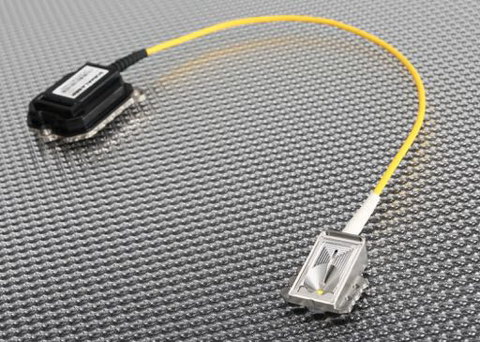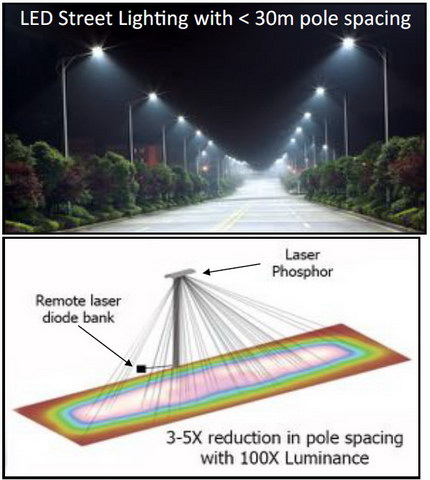SLD Laser, (formerly SoraaLaser) is a 2013 spin-out from Soraa Inc., developer and manufacturer of semi-polar GaN LEDs. SLD Laser focuses on semi-polar GaN blue lasers. I recently had a chance to talk to Dr. Paul Rudy, Cofounder, CMO & SVP BD of SLD Laser, about the company and its technology.

He said that SLD Laser is a true spin-out of Soraa, not a subsidiary, and currently the company has about 100 employees. SLD Laser and Soraa do not have common ownership, although Dr. Rudy told me they do have some investors in common. They share manufacturing space but he told me SLD Laser has its own equipment, such as GaN reactor vessels dedicated to the production of blue lasers. Both companies focus on semi-polar GaN for illumination applications. The focus at Soraa is on LED lighting and the focus at SLD Laser is on the use of lasers for illumination applications, which include the illumination of displays, especially projectors.
SLD Laser direct illumination SMD system which produces 400 – 500 lumens from a 300 – 400 micron spot. (Credit: SLD Laser)
The SLD Laser system involves using high-powered blue laser diodes to illuminate a phosphor to generate white light. All the examples Dr. Rudy discussed with me used yellow phosphors, similar to the ones used to generate white light from LEDs. All the systems SLD Lasers is currently focusing on use static phosphors, not phosphors on rotating wheels as are used in lasr-phosphor projectors.
The key difference between white LEDs and the SLD Laser system is that the SLD Laser system has a brightness (lumens per unit area) of 50x – 100x the brightness of a LED. This much higher lumen density allows the light generated, which has a lambertian distribution like an LED, to be controlled and directed with smaller optics. Dr. Rudy said that with the same size optics, the beam angle from a SLD Laser source would have 1/5th to 1/10th the beam angle of an LED with a similar lumen output. Alternatively, optics 1/5th to 1/10th the size of LED optics could be used and generate the same beam angle as the LED. He showed me images of tests where SLD Laser-powered spotlights illuminated objects up to 1 km away.
 Spectral output of a SLD Laser source compared to a LED source with the same color temperature. (Source: SLD Laser)
Spectral output of a SLD Laser source compared to a LED source with the same color temperature. (Source: SLD Laser)
The spectrum of the light from the laser source is very similar to the spectrum of a white LED with the same color temperature, as shown in the figure. The noticeable (and expected) difference is the very narrow bandwidth of the blue laser peak, compared to the blue LED peak.
 Fiber coupled source from SLD Laser (Credit: SLD Laser)
Fiber coupled source from SLD Laser (Credit: SLD Laser)
At CES, SLD Laser actually showed two versions of their technology. The first was a 7mm square integrated system in a SMD package. The second was a system that separated the laser from the phosphor and connected the two packages with an optical fiber. This allows for a completely passive package for the light source. Very efficient fiber is used, 99.8% transmission per meter, so there is very little loss of the blue light in most applications. For example, 98% of the light would make it to the end of a 10M fiber. Dr. Rudy said this would be beneficial, for example, in a street light application where the electronics and laser could be at ground level, for easy maintenance, while the phosphor could be in a hermetically sealed package at the top of the light pole.
 Top: Typical LED street lighting. Bottom: Street lighting with a SLD Laser source. (Credit: SLD Laser)The small spot size of the light allows luminaries with a SLD Laser source to produce sharp edges in the output, roughly 10x sharper than can be achieved with LED illumination. This can be important in some applications where the intention is to illuminate only certain areas. For example, SLD Laser equipped street lights could focus more of the light on the road than LED street lights, reducing light pollution in nearby homes. In addition, the very high directivity of the light would allow longer distances between light poles, with the poles perhaps 3x to 5x farther apart, compared to LED streetlights.
Top: Typical LED street lighting. Bottom: Street lighting with a SLD Laser source. (Credit: SLD Laser)The small spot size of the light allows luminaries with a SLD Laser source to produce sharp edges in the output, roughly 10x sharper than can be achieved with LED illumination. This can be important in some applications where the intention is to illuminate only certain areas. For example, SLD Laser equipped street lights could focus more of the light on the road than LED street lights, reducing light pollution in nearby homes. In addition, the very high directivity of the light would allow longer distances between light poles, with the poles perhaps 3x to 5x farther apart, compared to LED streetlights.
 SLD Laser sources can be used with a variety of projection technologies. (Credit: SLD Laser)
SLD Laser sources can be used with a variety of projection technologies. (Credit: SLD Laser)
While the current focus of SLD Lasers is on illumination applications such as automotive headlights, spotlights and street lighting, they are aware that the technology has potential for use in displays as well. They have demonstrated its use with DLP, LCoS and scanned projection systems.
 Spatially programmable illumination. (Credit: SLD Laser)
Spatially programmable illumination. (Credit: SLD Laser)
One display-related application is the use of the SLD Laser technology for spatially programmable lighting, as shown in the image. By scanning the blue laser beam over the phosphor area and then imaging the phosphor area, the technology can produce a directable and aimable spotlight where there is not need for motion except in the MEMS device. With rapid scanning, a pattern of light can be generated. For example, a square of light could frame something that needs highlighting. It would also be possible to switch from scanning a small area to a larger area of the phosphor, electronically converting the system from a spotlight to a floodlight without the need for a zoom lens.
 Layout of a Li-Fi system (Credit: Emmanuel Puybaret/eTeks)
Layout of a Li-Fi system (Credit: Emmanuel Puybaret/eTeks)
Li-Fi is another application of the technology. The laser can be modulated very quickly and Dr. Rudy said communications have been demonstrated at 3.6 GB/sec and the system has the potential to reach 100GB/sec. The phosphor responds more slowly than the laser so it would be necessary to filter out the yellow light at the receiver and look at only the received blue light. This could be used, for example, to allow two smart cars with these systems as headlights to communicate with each other.
He also said this could be used in a smart home or business application, where the ambient light supplied data to various devices in the home or office. I’ve seen LiFi proposals before and one problem they have is they are strictly one-way: data can be downloaded from the host running the Li-Fi system to the individual devices but the individual devices still need a wireless connection such as Wi-Fi, Bluetooth or Zigbee to communicate with the host.
According to Dr. Rudy, SLD Laser is shipping to potential customers now and their products are in the qualification phase. He expects the first products containing SLD Laser light sources to ship in the second half of this year. –Matthew Brennesholtz

